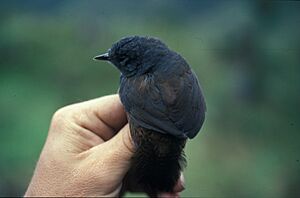Blackish tapaculo facts for kids
Quick facts for kids Blackish tapaculo |
|
|---|---|
 |
|
| Conservation status | |
| Scientific classification | |
| Genus: |
Scytalopus
|
| Species: |
latrans
|
 |
|
The blackish tapaculo (Scytalopus latrans) is a small, shy bird that lives in the mountains of South America. It belongs to a family of birds called Rhinocryptidae. These birds are often hard to spot because they hide in thick bushes. You can find this bird in countries like Colombia, Ecuador, Peru, and Venezuela.
Contents
About This Bird's Family
Scientists who study birds, called ornithologists, classify animals to understand them better. The blackish tapaculo was first described as its own unique species. Later, it was thought to be a type of unicolored tapaculo. However, scientists eventually decided it was a full species again.
There are two main types, or subspecies, of the blackish tapaculo. One is called the "blackish" type (S. l. latrans). The other is the "Pacific" type (S. l. subcinereus). Sometimes, the "Pacific" type is even thought to be a separate species.
What Does It Look Like?
The blackish tapaculo is about 11 centimeters (4.3 inches) long. Males usually weigh between 16 to 21 grams (0.56 to 0.74 ounces). Females are a bit lighter, weighing 14 to 20 grams (0.49 to 0.71 ounces).
The male "blackish" subspecies is dark gray, sometimes almost black. The female is also dark gray, but can have a slight olive color. Young birds of this type are not well known, but are thought to be dull brown.
The male "Pacific" subspecies is black. Its female is gray, darker on top and lighter underneath, with brown sides. Young birds of this type are brown.
Where Does It Live?
The "blackish" subspecies lives on both sides and inside the Andes mountains. You can find it from western Venezuela through Colombia and Ecuador to northern Peru. The "Pacific" subspecies lives on the western side of the Andes in southwest Ecuador and northwest Peru. These birds usually stay in one area and do not migrate.
The blackish tapaculo prefers the lower parts of moist montane forests. These are forests found in mountains, usually between 1,500 and 4,000 meters (4,900 to 13,100 feet) high. They often live near Chusquea bamboo and Polylepis scrub plants. They also live in other shrubs, wet areas, and places where forests are regrowing.
How Does It Behave?
What It Eats
The blackish tapaculo looks for food on or near the ground. It picks small arthropods (like insects or spiders) from the soil, moss, leaves, and plant stems.
How It Raises Young
Scientists do not know much about how the blackish tapaculo breeds. Only one nest has ever been found. It was shaped like a ball and built in an earthen bank. The nest was covered with clubmoss and ferns.
Is It Endangered?
The IUCN (International Union for Conservation of Nature) has looked at the blackish tapaculo's population. They have rated it as a species of "Least Concern." This means that its population is stable and not currently at risk of disappearing.


